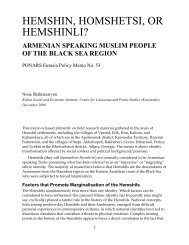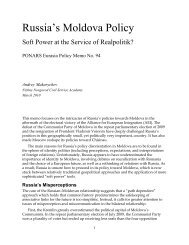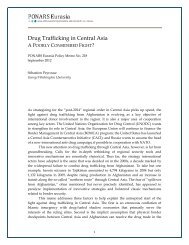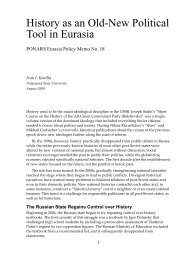View the Policy Memo (PDF) - PONARS Eurasia
View the Policy Memo (PDF) - PONARS Eurasia
View the Policy Memo (PDF) - PONARS Eurasia
Create successful ePaper yourself
Turn your PDF publications into a flip-book with our unique Google optimized e-Paper software.
Despite its marginality, this movement can still pose a serious terrorist threat to<br />
international security.<br />
Whichever of <strong>the</strong> two approaches one follows, it is <strong>the</strong> micro-cell level to which<br />
elements of “leaderless resistance” apply. The movement does not recruit into a preexisting<br />
framework but encourages people to start <strong>the</strong>ir own cells to fur<strong>the</strong>r its ends;<br />
<strong>the</strong>re is little or no intra-movement communication between cells; <strong>the</strong> idea of starting a<br />
violent cell appeals as much to young males’ desire for glory and <strong>the</strong>ir personal<br />
conscience as to <strong>the</strong>ir political or ideological beliefs. This list of characteristics is actually<br />
a description of <strong>the</strong> ELF (see Joosse 2007), but it equally applies to <strong>the</strong> micro-cell level of<br />
global jihad, if not to <strong>the</strong> movement’s dispersed ideological and strategic leaders nor its<br />
regional affiliates.<br />
“Lone Wolves” and “Global Jihad”<br />
While “leaderless resistance” originates from an organization-centered perspective,<br />
“lone wolves” act outside organizational frameworks.<br />
On <strong>the</strong> one hand, “lone wolf” terrorism remains a relatively marginal<br />
phenomenon. The absolute majority of terrorist attacks are carried out by organized<br />
groups. The number of incidents plotted or carried out by “lone wolves” is miniscule:<br />
<strong>the</strong>y make up less than 1.8 percent of terrorist attacks in Western states between 1968–<br />
2010. Single actors display less destructive capacity, sustainability, and longevity. With<br />
<strong>the</strong> exception of several mass-casualty attacks, acts of “lone wolf” terrorism are less<br />
deadly: <strong>the</strong>y have an average lethality of 0.6 deaths per incident, a statistic that has not<br />
appeared to increase over time.<br />
On <strong>the</strong> o<strong>the</strong>r hand, “lone-wolf” jihadist terrorism in <strong>the</strong> West shows some<br />
marked specifics. Islamist terrorists, who only became a significant issue from <strong>the</strong> 1980s<br />
and early 1990s, already account for 15 percent of <strong>the</strong> total number of single-actor<br />
attacks in <strong>the</strong> West over <strong>the</strong> past 40 years, second only to right-wing extremists with 17<br />
percent. 4 “Lone wolf” attacks also account for a much higher proportion of global jihad<br />
incidents, compared to o<strong>the</strong>r types of terrorist incidents: 14 percent of all plots and<br />
attacks by jihadist actors in Western Europe between 1995 and 2012. 5 Single-actor<br />
jihadist incidents aim at more casualties, as half of all plots involve mass casualty<br />
bombings. Also, while throughout <strong>the</strong> 2000s a gradual increase in “lone wolf” terrorist<br />
incidents mostly affected Western Europe, in <strong>the</strong> late 2000s and early 2010s, jihadist<br />
plots and attacks of this type also increased in <strong>the</strong> United States. Out of 40 such attacks<br />
committed or prevented in <strong>the</strong> United States between 2001 and 2011, over half occurred<br />
between 2009–2010. In 2010, CIA director Leon Panetta described “lone-wolf” terrorism<br />
as <strong>the</strong> main terrorist threat to <strong>the</strong> United States.<br />
There are enough cases of “lone wolf” attacks to give rise to typologies of single<br />
actor terrorism, jihadist or o<strong>the</strong>rwise (see, for example, works by Petter Nesser and<br />
4 Ramón Spaaij, “Understanding Lone Wolf Terrorism: Global Patterns, Motivations and Prevention,”<br />
Springer Briefs in Criminology (Dordrecht; Heidelberg; London; New York: Springer), 2012.<br />
5 Petter Nesser, “Single Actor Terrorism: Scope, Characteristics and Explanations,” Perspectives on Terrorism<br />
6, no. 6 (2012).<br />
4










